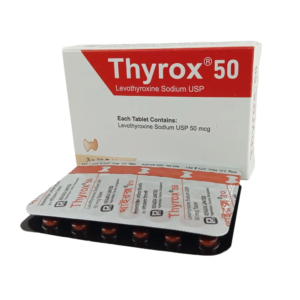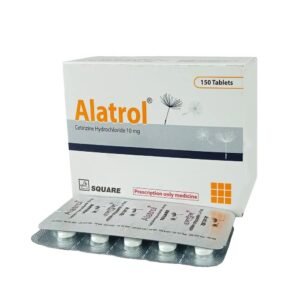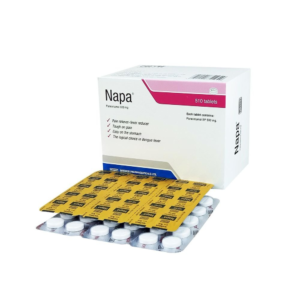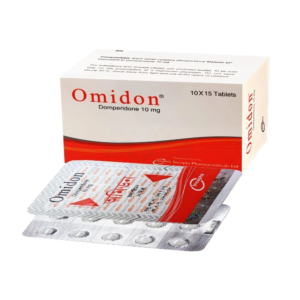Disopan 0.5 Tablet – (0.5mg)
৳ 72.72৳ 80.00 (-9%)
Medicine Overview of Disopan 0.5 0.5mg Tablet
Disopan 0.5 is a prescription medicine used to treat epilepsy (seizures), panic and anxiety disorder. It helps to decrease the abnormal and excessive activity of the nerve cells and calms the brain. Disopan 0.5 may be taken with or without food. However, take it at the same time each day as this helps to maintain a consistent level of medicine in the body. Take this medicine in the dose and duration as advised by your doctor as it has a high potential of habit-forming. If you have missed a dose, take it as soon as you remember it and finish the full course of treatment even if you feel better. You should not stop this medicine suddenly without talking to your doctor as it may increase the seizure frequency and can cause nausea, anxiety, flu-like symptoms, and muscle pain. Some common side effects of this medicine include fatigue, depression and impaired coordination. It may also cause dizziness and sleepiness, so do not drive or do anything that requires mental focus until you know how this medicine affects you. It is important to inform your doctor if you develop any unusual changes in mood or depression as this medicine may cause suicidal thoughts.
- Anxiety disorder
- Epilepsy/Seizures
- Depression
- Dizziness
- Drowsiness
- Fatigue
- Impaired coordination
-
The addiction / habit-forming potential of this medicine is very high. Take it only as per the dose and duration advised by your doctor
-
It may cause dizziness. Do not drive or do anything that requires mental focus until you know how this medicine affects you.
-
Avoid consuming alcohol as it may increase dizziness and drowsiness.
-
Inform your doctor if you are pregnant, planning to conceive or breastfeeding.
-
Inform your doctor if you experience worsen anxiety, depression angry, or violent behavior and mania while taking this medicine.
-
Do not stop taking medication suddenly without talking to your doctor as that may lead to nausea, anxiety, agitation, flu-like symptoms, sweating, tremor, and confusion.
Epilepsy, Anxiety disorders, Panic disorder, Status epilepticus, Social phobia, Migraines, Parasomnia, Restless legs syndrome, Rapid eye movement, Behavior disorder, Spasticity, Resistant depression, Trigeminal neuralgia, Nocturnal myoclonus, Post traumatic stress disorder, Insomnia and sleep disturbances, Burning Mouth Syndrome
Oral Epilepsy Adult: Initially, 1 mg given at night for 4 days, gradually increased over 2-4 wk. Maintenance: 4-8 mg/day. Max: 20 mg/day. Elderly: Initially, 0.5 mg at night for 4 days. Panic disorder Adult: Initially, 0.25 mg bid, increased after 3 days up to 1 mg/day. Max: 4 mg/day. Intravenous Emergency management of status epilepticus Adult: 1 mg by slow IV inj over at least 2 min or by infusion, repeated if necessary. Max: 20 mg. Hepatic impairment: Dosage adjustment may be needed.
Oral Epilepsy Child: <10 yr or <30 kg: Initially, 0.01-0.03 mg/kg/day but not to exceed 0.05 mg/kg/day given in 2 or 3 divided doses. May be increased by no more than 0.25-0.5 mg every 3rd day until seizure control is achieved. Maintenance: 0.1-0.2 mg/kg/day divided 3 times daily. Max: 0.2 mg/kg/day. Intravenous Emergency management of status epilepticus Child: 500 mcg by slow IV inj or by infusion.
Neonates, chronic pulmonary insufficiency, hepatic/renal dysfunction, porphyria, elderly; pregnancy and lactation. Lactation: Excreted in breast milk; not recommended
10% Somnolence (37%) 1-10% Abnormal coordination (5-10%),Ataxia (5-10%),Depression (5-10%),Dizziness (5-10%),Fatigue (5-10%),Memory impairment (5-10%),Upper respiratory infection (5-10%),Confusion (1-5%),Dysarthria (1-5%),Rhinitis (1-5%),Coughing (1-5%),Urinary frequency (1-5%),Impotence (1-5%),Decreased libido (1-5%) Frequency Not Defined Increased salivation,Worsening tonic-clonic seizures Potentially Fatal: Salivary or bronchial hypersecretion leading to respiratory problems (children). May produce diminished reflexes or coma. Rarely, blood dyscrasias.
Pregnancy There are no adequate and well-controlled studies of Klonopin in pregnant women; available human data on risk of teratogenicity are inconclusive; there is insufficient evidence in humans to assess effect of benzodiazepine exposure during pregnancy on neurodevelopment; administration of benzodiazepines immediately prior to or during childbirth can result in a syndrome of hypothermia, hypotonia, respiratory depression, and difficulty feeding; in addition, infants born to mothers who have taken benzodiazepines during later stages of pregnancy can develop dependence, and subsequently withdrawal, during the postnatal period Data for other benzodiazepines suggest possibility of adverse developmental effects (long-term effects on neurobehavioral and immunological function) in animals following prenatal exposure to benzodiazepines Lactation Effects on breastfed infant and on milk production are unknown; developmental and health benefits of breastfeeding should be considered along with mother’s clinical need for therapy and any potential adverse effects on breastfed infant from drug or from underlying maternal condition













Reviews
There are no reviews yet.